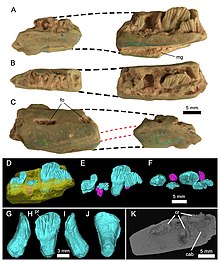Souvrství Griman Creek

Souvrství Griman Creek je geologickým souvrstvím nacházejícím se na území států Nový Jižní Wales a Queensland v Austrálii. Vrstvy o mocnosti až 345 metrů zde mají stáří asi 105 až 96 milionů let, pocházejí tedy z období "přelomu" rané a pozdní křídy (věky alb až cenoman). Hlavními typy hornin zde jsou pískovce, prachovce a jílovce.[1]
Paleontologie
Toto souvrství je známé především hojnými objevy dinosaurů, byli tu však objeveni také mnozí zástupci dalších skupin obratlovců, včetně želv, krokodýlů, ptakoještěrů a primitivních savců. Griman Creek je v současnosti nejbohatší australskou formací z hlediska množství popsaných taxonů druhohorních dinosaurů (spolu s geologickým souvrstvím Eumeralla).[2]
Dinosauří taxony

- Fostoria dhimbangunmal
- Fulgurotherium australe[3]
- Rapator ornitholestoides
- Walgettosuchus woodwardi
- Weewarrasaurus pobeni
- Ankylosauria indet.
- Megaraptora indet.[4]
- Noasauridae indet.
- Sauropoda indet.
Odkazy
Reference
- ↑ Bell, P. R.; et al. (2019). Revised geology, age, and vertebrate diversity of the dinosaur-bearing Griman Creek Formation (Cenomanian), Lightning Ridge, New South Wales, Australia. Palaeogeography, Palaeoclimatology, Palaeoecology. 514: 655–671.
- ↑ Ruairidh J. Duncan, Alistair R. Evans, Patricia Vickers-Rich, Thomas H. Rich & Stephen F. Poropat (2021). Ornithopod jaws from the Lower Cretaceous Eumeralla Formation, Victoria, Australia, and their implications for polar neornithischian dinosaur diversity. Journal of Vertebrate Paleontology. Article: e1946551. doi: https://doi.org/10.1080/02724634.2021.1946551
- ↑ SOCHA, Vladimír. Ještěr společnosti Atlas Copco. OSEL.cz [online]. 8. června 2021. Dostupné online. (česky)
- ↑ SOCHA, Vladimír. Megaraptoři. OSEL.cz [online]. 2. listopadu 2018. Dostupné online. (česky)
Literatura
- Frauenfelder, T. G.; et al. (2020). Diversity and palaeoecology of Australia's southern‐most sauropods, Griman Creek Formation (Cenomanian), New South Wales, Australia. Lethaia. 0: 1-14.
Externí odkazy
- SOCHA, Vladimír. Nejbohatší geologická souvrství světa. OSEL.cz [online]. 12. března 2021. Dostupné online. (česky)
Média použitá na této stránce
Autor: Slate Weasel, Licence: CC0
Skeletal diagram of the Australian megaraptoran Rapator ornitholestoides. Its axial length is approximately 4.8 meters.
References
- White, Matt A.; Falkingham, Peter L.; Cook, Alex G.; Hocknull, Scott A.; Elliott, David A. (2013). "Morphological comparisons of metacarpal I for Australovenator wintonensis and Rapator ornitholestoides: implications for their taxonomic relationships". Alcheringa 37 (4): 435-441. DOI:10.1080/03115518.2013.770221.
- Australovenator skeletal by Ashley Patch (PLASTOSPLEEN)
Autor: Phil R. Bell, Matthew C. Herne, Tom Brougham, Elizabeth T. Smith, Licence: CC BY 4.0
Right dentary in (A), medial; (B), dorsal; and (C) lateral views. Dashed black lines represent approximate contours of the missing areas. Dashed red lines indicate the distinctive banding pattern in the opal used to estimate the extent of the missing area. (D–F) Three-dimensional renders of the posterior dentary fragment in (D) lingual view showing erupted (blue) and developing germ teeth (pink); (E) Same as (D) but with dentary removed; (F) dorsal (occlusal) view of tooth row. (G-J) Three-dimensional render of the best-preserved tooth in (G) mesial, (H) lingual, (I) distal, and (J) labial views. (K) MicroCT scan of the posterior dentary fragment in axial view showing preservation of cancellous bone. Abbreviations: cab, cancellous bone; cr, tooth crown. Photo credit: Phil Bell.

